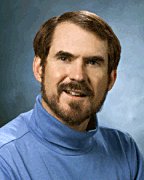Reprinted from Massage Today,
February
2001 (Vol. 1, Num. 2)
P.O. Box 6070 Huntington Beach, CA 92615 •USA
 |
|
The RamblemuseSMKeith Eric Grant, Ph.D. |
Attention to Learning
A man came to the Zen master Ikkyo and asked him for some words of wisdom to guide him in life. Ikkyo nodded agreeably and wrote on a piece of paper the word 'attention'. The man said he could not understand and asked for something more. Ikkyo wrote 'attention, attention'. After a further request for an explanation, Ikkyo wrote his final statement for the man, 'Attention, attention, attention means attention. —Lawrence LeShan, How to Meditate. (New York, Little, Brown & Co., 1974), 54.
Kinesthetic Roots
The last couple of weeks I have succumbed to the pleasures of revisiting some long fallow kinesthetic roots. Back when I was a graduate student in physics, I had started taking massage and dance classes to enforce some sense of balance in my life. Surprisingly, many of the movement patterns required to massage effectively seemed almost innate to me. It was only years later, when I began teaching massage, that I realized the reason behind this naturalness was several years further back in time. There had been a period when, for much the same reasons of balancing life, I had baked the majority of the bread I used.
During this period of regular bread making, I had learned to move with my whole body to knead the bread, rather than relying only on the more quickly tiring intrinsic muscles of my hands and forearms. I had developed a relaxed and steady tempo that allowed me to maul the dough into its required elasticity without tiring. Finally, I had developed my sense of touch to feel the subtle changes in texture that occurred as the dough neared the point at which it was ready for its first rising. Thinking back as I recently made bread once again, I acknowledged that my first "massage instructor" used no words but gave me much feedback. From a behaviorist viewpoint, my attention and efforts were rewarded and reinforced by the bread I ate and shared with friends. When I began to learn massage, these neuromuscular patterns were already in place to transfer to a new and equally rewarding application.
What this story exemplifies for me is the diversity of kinesthetic and interpersonal skills that we bring to our first formal massage class. Both skills of interpersonal awareness and communication and those that require learning movement patterns can be transferred to new applications. Our minds and bodies don't care that we originally learned them for another purpose. Often, we learned them early and use them without being conscious of that use or of when we practiced and perfected them. In thinking of such skills as innate or intuitive, we fail to acknowledge those who modeled them and reinforced them, in some instances before we had words capable of expressing our gratitude. We also fail to remember the amount of attention, awareness, and practice that was required of us. Returning our awareness to these early lessons allows us a model for what we already do well and for extending our learning in new directions and to new depths.
Stages of Competence
Robert Jolles is a trainer of trainers for Xerox. In his book How to Run Seminars and Workshops, he presents a model for the stages of learning a new skill. The four stages are unconscious incompetence, conscious incompetence, conscious competence, and unconscious competence. Following this model, in the beginning we are unaware that we don't have a skill in place and may also be unaware of our need for the skill. As we progress, we become aware that we both need a skill and that we haven't mastered it. At this stage, we turn our focus and attention on learning and practicing the skill. Sometimes someone breaks it down into small increments for us; sometimes we practice the whole of what we see demonstrated, as best we can. As we practice, we begin to learn new perceptions and motor skills and can add further refinements to practice. At last, when we consciously think about it, the skill is ours to use. Finally, with more use and practice, the skill becomes natural to us and we begin to use it unconsciously. We have completed our initial progress through the stages of learning, but over time will have to bring our attention back to it again and again to adapt to changing conditions, regain proficiency after a lapse of use, and to keep current with new innovations.
Awareness Follows Attention
The actual process of learning occurs by becoming aware of interactions we previously did not perceive and by consciously practicing movements until they become part of our kinesthetic vocabulary. In perception, awareness follows attention. As we consciously remind ourselves to attend to what our sense of touch is telling us as we massage a classmate or client, our awareness of differences in shape and tissue texture sharpens. As we consciously attend to nuances in other's gestures and body posture, our abilities to consciously be aware of the communications we are receiving increases. We can enhance our nonverbal perceptions by exposure, such as watching a movie with the sound off or observing the body usage of those conversing in a coffeehouse. Finally, as we practice movements with attention, we become aware of what we tried and what resulted. When we observe ourselves and non-critically note the result, we allow ourselves to learn new kinesthetic vocabulary —short habitual patterns of movement and balance that are the basis for our abilities to walk, dance, ski, play a musical instrument, and to practice massage.
As we learn and practice, the behaviors and skills that are reinforced by our environment and our internal values take hold, now as they did in our early lives. Given motivation and a gentle hand, there are few limits to what we can accomplish via the direction of our attention.